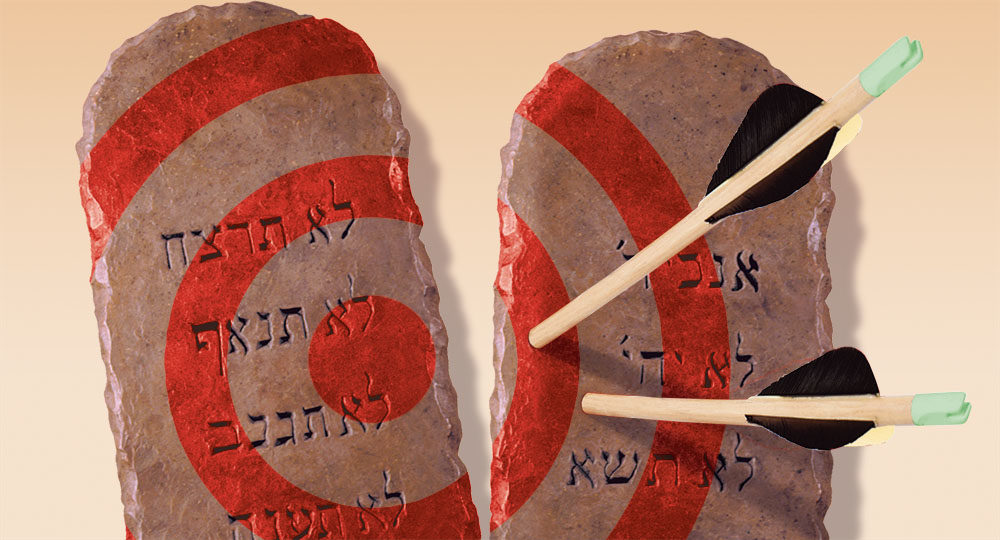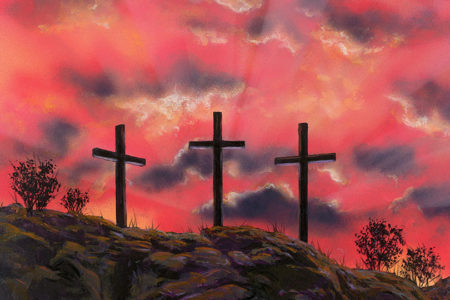Solving the Sin Problem
We believe that sin is anything that does not conform to the character and nature of God. We believe that all mankind sinned in Adam, the head of the human race, and that each human being has a sin nature and also has committed personal sin.
So reads The Friends of Israel’s doctrinal statement. Although sin entered the world through Adam and Eve, the knowledge of sin came through the Mosaic Law given to the Jewish people on Mount Sinai. With the Law came the Tabernacle and later the Temple, where people could bring sacrifices to deal with their sin. But neither of those is around today. Consequently, the Jewish concept of sin has changed dramatically.
The biblical words translated “sin” are chet in Hebrew and hamartia in Greek. Both communicate the idea of missing the bull’s-eye of a target. In theology, the target is the righteousness of God. If you are not as good as God, you are a sinner. The Bible also describes behavior that “misses the mark” as transgression, rebellion, error, wickedness, ungodliness, and lawlessness.
Most Jewish people today do not view sin with such precision. While many Orthodox Jews see sin as simply choosing to break God’s law, more “modern” Jewish thinkers would say it is the breaking of civil laws. Yet many readily accept sin’s reality and the need to help people deal with it. Wrote Rabbi Morris Kertzer, “A postscript to every Jew’s life, uttered at his gravesite, are the words: ‘For there liveth no man on earth who is so righteous that he sinneth not.’”1
The Concept of Kedushah
The Torah (Five Books of Moses) makes it clear that God chose the Jewish people as His own. With such privilege also came great responsibility. Unlike Adam, who was given one command, the Jewish people were given 613. The first 365 are negative (“you shall not”), while the second 248 are positive (“you shall”).
The commands cover laws regarding man’s relationship with God and man’s relationship with man. Breaking or disobeying any one of them constitutes missing the mark of a holy God.
Adam and Eve’s disobedience resulted in their separation from God’s presence in the Garden of Eden and their ultimate death. Orthodox Judaism possesses a strong conviction about separation. The Hebrew word kadosh is often translated as “holy.” That is why observant Jewish people (by far the minority today) emphasize living holy, or separate, lives. God’s holiness is emphasized; it cannot commune with sin. The clean and unclean cannot exist together. God told the Jewish people, “You shall be holy, for I the Lᴏʀᴅ your God am holy” (Lev. 19:2).
When Moses stood before the burning bush, God told him to remove his sandals because he was standing on holy ground (Ex. 3:5). Moses’ disobedience of striking the rock rather than speaking to it to receive water in the wilderness separated him from the promise of entering the land he was leading the Israelites to possess (Num. 20:12).
This reminder of separation is incorporated into the Kedushah (sanctification) prayer: “I will be hallowed [treated as holy] among the children of Israel” (Lev. 22:32).
Many items in the Bible are called “holy” or “sanctified,” including the Ark of the Covenant, the priests’ garments, the Holy of Holies in the Tabernacle and Temple, the Sabbath, and the “holy convocations” (feasts). These were all set apart for God’s purpose and were, therefore, to be separate, pure, clean, and without spot. Any defilement rendered them unacceptable to God.
The widest of all separations came when Adam and Eve’s sin cost them their intimate fellowship with God and eternal life on Earth. They were consigned to go from dust to dust—to return to the ground from which they were taken (Gen. 3:19). Or, as the prophet Ezekiel wrote, “The soul who sins shall die” (Ezek. 18:4).
From Temple to Al Chet
From the giving of the Law until A.D. 70 when the Romans destroyed the second Temple in Jerusalem, the redress for sin was through a substitutionary blood sacrifice, as specified in the Torah. Today, during Rosh Hashanah (New Year) and Yom Kippur (Day of Atonement), many Jewish people spend all day praying, fasting (on Yom Kippur), and begging God to forgive their sins.
Reciting a prayer called Al Chet (“For the sins which I have sinned”), the congregation cries out in unison to God for forgiveness. The liturgy lists such sins as lying, cheating, bribery, covetousness, slander, and pride.
This change from Temple sacrifice to prayers of repentance is summed up in the Talmud in Midrash Avot D’Rabbi Nathan 4:5:
Once, Rabbi Yohanan ben Zakkai was walking with his disciple, Rabbi Y’hoshua, near Jerusalem after the destruction of the Temple. Rabbi Y’hoshua looked at the Temple ruins and said “Alas for us!!The place that atoned for the sins of the people Israel lies in ruins!” Then Rabbi Yohanan ben Zakkai spoke to him these words of comfort: ‘Be not grieved, my son. There is another equally meritorious way of gaining ritual atonement, even though the Temple is destroyed. We can still gain ritual atonement through deeds of loving-kindness. For it is written “Loving-kindness I desire, not sacrifice.” (Hosea 6:6)
That story, though not known by most Jewish people, is the template that encourages two major erroneous beliefs about sin: (1) that sin is a choice, not a nature, and (2) that we can get right with God through our own efforts.
The latter promotes the false teaching that one can do enough mitzvot, or good deeds, to overcome the bad. However laudable it is to spend time in confessional prayer and to fast and give of one’s time and money, none of these removes sin. The Hebrew Scriptures declare plainly, “All our righteousnesses [good deeds] are like filthy rags” (Isa. 64:6).
How does a Holy God forgive sinners?The answer is in Leviticus 17:11: “For the life of the flesh is in the blood, and I have given it to you upon the altar to make atonement for your souls; for it is the blood that makes atonement for the soul.”
On Passover in Egypt, God used the blood of the lamb to stay judgment from the first-born. On Yom Kippur in the days of the Temple, the priests sacrificed goats and used the blood to atone for the sins of the high priest and the nation. And when the time was right, Jesus the Messiah solved the sin problem forever by becoming the final sacrifice—the substitutionary atonement—for our sin.
No one can keep 613 commandments perfectly except God Himself. That is why God came to Earth in the person of Jesus. Jesus never missed the bull’s-eye; He kept the commandments for all of us and then took the punishment we deserve for breaking them. He arose from the grave because He is God, and He can set us free: “For Christ [Messiah] is the end of the law for righteousness to everyone who believes” (Rom. 10:4).
ENDNOTE
- Rabbi Morris N. Kertzer, What Is a Jew? 4th ed. (New York: Collier Books, 1978), 11.







Great article – Thank you! How do I get a subscription for the magazine – not digital?
Hi Sherry,
Thank you! If you are a first-time subscriber, you can receive a free, one-year print trial by visiting foi.org/img-trial.
AS christians, do we have to keep the sabbath? Thank you and blessings from the Lord!!